
IMPROVING CAMPUS INFRASTRUCTURE
Some of the major improvements to infrastructure completed over the summer are very visible; others are not. Read in this issue about the many major projects completed by Physical Facilities and Information Technology Services, as well as the new programs offered by the University Center for Training and Development.

SCHOOL OF PHARMACY AND PHARMACEUTICAL SCIENCES OPENS NEW BUILDING
The opening of the new, $60-million School of Pharmacy and Pharmaceutical Sciences at the University's Health Sciences Campus in Johnson City, N.Y., headlines this quarterly report, but there's also good news about collaborations, external funding and student successes. Read more in this issue.
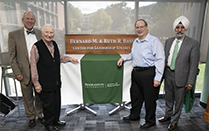
SUCCESSFUL INITIATIVES SUPPORT STUDENTS
It takes donors at many levels to make Binghamton University successful, and in this issue of the quarterly report, you can read about a number of them. Whether it's AVANGRID offering full-tuition scholarships and capstone project support, or playing golf to benefit the Alumni Legacy Scholarship, the Division of Advancement works with Binghamton supporters.
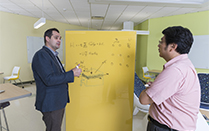
BINGHAMTON RESEARCH FUNDING SETS RECORD
Binghamton University reported research expenditures totaling $47.5 million in 2017-18, an increase of about 19 percent from the previous fiscal year. The figure tops 2011-12, the campus’ all-time best year for research funding, when just over $40 million was reported. The new record, which follows several years of steady growth, is an important sign of the campus’ creativity and innovation. Healthcare research accounted for nearly a third of expenditures, with electronics packaging and systems engineering following at about 22 percent.

BAXTER THE BEARCAT BOOSTS SCHOOL SPIRIT
The Division of Student Affairs spent the summer hosting students and families for orientation and preparing for the opening of the fall semester. With some new people on board and some others with new duties, it has been a busy time. Not too busy, though, to show Binghamton University pride, as you'll read about the new Baxter the Bearcat Bench in the University Union in this issue.
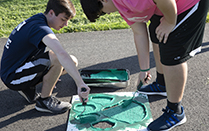
STUDENT-ATHLETES CONTINUE TO SUCCEED ACADEMICALLY
Student-athletes continue to shine on and off the courts and fields. The Athletics Department sets high academic standards, and student-athletes surpass them across the board. Read about the accomplishments made by student-athletes in their sports and in the classroom – and check out the videos showcasing fall sports and the new women's head basketball coach, Bethann Shapiro Ord, in this issue.
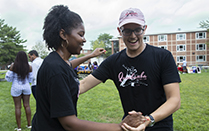
HELPING TO MAKE THE CAMPUS MORE INCLUSIVE
The Division of Diversity, Equity and Inclusion works to educate and empower everyone on campus in ways that create a welcoming community. From the Udiversity Educational Institute, that holds trainings for students, faculty and staff, to the Multicultural Resource Center and Q Center, the division's offices that work to build bridges and support students though education and events such as Sundaze, part of its Welcome Week programming. Read about the division's recent initiatives in this report.
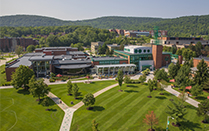
DONOR SUPPORT ADVANCES BINGHAMTON UNIVERSITY
The Binghamton University Foundation had a successful 2017-18 year, bringing in the second highest amount of cash ever in support of the University. Read the numbers in this issue of the quarterly report, and learn one way the Foundation celebrates its donors.
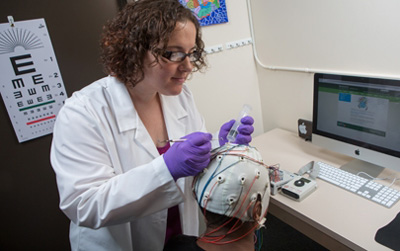
Study aims to understand dyslexia
Neuroscientist Sarah Laszlo wants to understand what’s going on in children’s brains when they’re reading. Her research may untangle some of the mysteries surrounding dyslexia and lead to new methods of treating America’s most common learning disorder.
“The brain can reveal things that aren’t necessarily visible on the surface,” she says. “It can tell you things about what’s going wrong that you can’t find out by giving a kid a test or asking him to read out loud.”
Laszlo, who joined Binghamton’s psychology department in 2011, recently received a five-year, $400,763 grant from the National Science Foundation’s Early Career Development (CAREER) Program, the agency’s most prestigious award for young researchers. The funding will enable her to conduct a five-year brain
activity study of 150 children with and without dyslexia.
Rather than lumping all children with dyslexia into one group, as many previous brain-imaging studies have done, Laszlo’s project will help to establish types and degrees of the disorder.
Her lab uses electroencephalography, or EEG, as a non-invasive way to measure the electrical signals sent between brain cells when they’re communicating with each other. Study participants — kids in kindergarten through fourth grade — wear a cap outfitted with special sensors while playing a
computerized reading game.
These scans produce massive amounts of data: The cap’s 10 sensors collect readings 500 times per second for 45 minutes. That’s one reason that brain activity studies are expensive and time-consuming. It’s also the reason that a study of just 150 children is the largest study of its kind.
Learn more about the study and how to participate
.